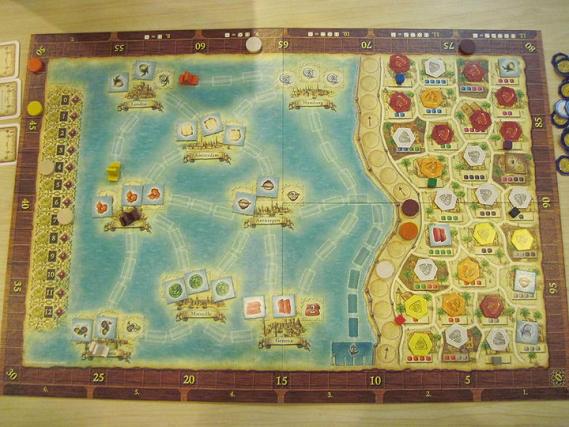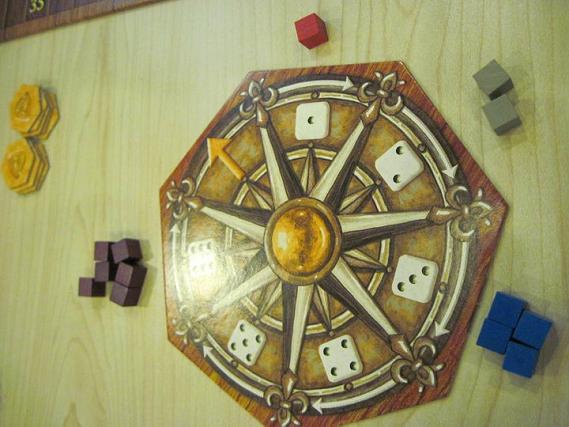
I’m not going to cover this one extensively. This is another one that Hiew has written a comprehensive review of, plus I have mixed feelings about it and really need to play it more to make up my mind about it. The central attraction in Macao is the set of six differently colored dice that everyone essentially shares. One player rolls the lot of them and each player gets to choose any two of the dice results to use. It doesn’t matter if another player chooses the same two colors. This gives you two types of resource cubes to use with the amount of each equaling the respective die result.
The cool part is that the higher the die result you pick, the later it becomes available. So if you’re content with accepting a die result of 1, you get a resource cube of that color this turn, but if you decide to go for a die result of 6, you’ll need to wait an extra five turns to be able to spend it. It’s a very neat if sometimes frustrating system. The problem is that the different uses these resource cubes can be put to seem rather boring and somewhat cluttered to me.
You can use specific numbers and colors of the cubes to claim the various quarters of Macao on the board and to activate the various cards that you place on the mat. More generic uses are spending cubes of color to advance along the turn order track or to move your ship. The cards introduce tension as you must take a card every turn and your mat can only hold so many unactivated cards. If you have too many, you’re docked points for each card you’re forced to discard. This means you’re forced to choose between taking cards that you’re confident of activating easily or cards that are actually useful to you.

Claiming city quarters give you trade goods which your dinky little ship can deliver to various destinations in return for victory points. At the end of the game, you also get bonus points for having a set of claimed quarters linked together in a network. Activating cards often gives you a special power that you can use once per round, with effects such as getting a specific colored cube, selling one for money or giving you a discount for activating some types of cards. Some cards also provide bonus victory points based on certain conditions. Finally, each round players are allowed to buy victory points using cash, with cost and point totals that vary from round to round.
My main beef with this game is that the way the resource cubes come into play obviously calls for long-term planning, yet it’s impossible to predict which cards you’ll end up taking. Add to the fact that some cards are consistently useful while others seem valuable only in combination with certain other cards, and it all adds up to a planning nightmare. Claiming city quarters is more predictable but there’s no guarantee that you’ll grab something you’re aiming for before another player takes it. This means that players seem to simply try to get a variety of resource cubes every turn and hope for the best when it’s time to spend them. That feels very unsatisfying to me.
My other problem is that the name of the game seems to have been derived by looking at a list of countries and picking one that hasn’t already been made into a game. I just can’t figure out why it’s called Macao. I’m no historian but the portrayal of the colony as a major exporter to so many different European cities seems wrong to me. As far as I know, the trade was very much dominated by the Portuguese who didn’t look kindly on the ships of the other European powers trying to muscle in on the business. Why include these European cities instead of historically more likely candidates such as Malacca, Manila, Nagasaki and Guangzhou?

Again, I could be wrong and maybe I’ll change my mind once I play this one more, but right now, it seems to me that there’s very little to like about Macao other than its interesting dice allocation mechanic. The rest of the game feels like a tacked on mishmash of familiar euro elements. I quite liked designer Stefan Feld’s In the Year of the Dragon after spending time messing around with the Flash version, and one reason for that is how focused and tight the game feels due to the extremely constrained set of decisions available.
Macao would, in my opinion, be a better game if it had a similarly small set of decisions and a more predictable set of future situations. Players might then be obliged to reveal their choice of rolled dice in turn order, effectively letting other players know what they’re aiming for in future turns and allowing them to decide in advance whether to compete for it or go for something else on another turn. But then I’m just an armchair designer, so what do I know?
Leave a Reply